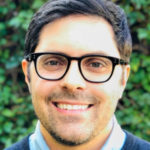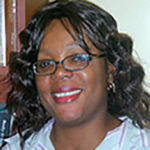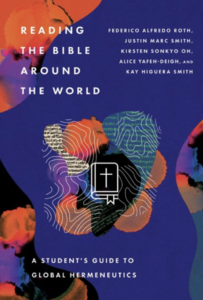About Reading the Bible Around the World
A Conversation with Federico Alfredo Roth and Justin Marc Smith
Every Voice: What led you to put this book together? What problem or issue(s) are you seeking to address?
Federico Roth and Justin Smith: Dating back to the early 2000s, we (professors in the School of Theology at Azusa Pacific University, a liberal arts college just east of Los Angeles) began encouraging students to read their Bibles with a growing sensitivity to narratives beyond their own. That is, we began asking our students to recognize the many ways in which communities of faith engage the Bible out of their unique social and historical locations. We accomplished this with varying success. At times the reading resources we offered were written for a graduate audience, and so, often difficult for our undergraduates to grasp. Other times the materials would be too “harsh” or not overtly pastoral. Where readings were effective, they were often written by a single author and so, would require the given author to speak into or for contexts that were not their own. An additional challenge was that many of our students came into our classrooms with the idea that there was ONLY a single way to effectively read Scripture. In order to move them in the direction of seeing and understanding other approaches, we needed a different resource.
What we wanted to do was produce a book on the topic of contextual/global approaches that was at once pastoral in its approach and, moreover, written from the lived experiences of a variety of authors, each embodying and representing different social locations.
EV: What is the thesis of your book?
FR&JS: The book is less thesis-oriented and more oriented toward detailing ways of reading from different vantage points (global, ethnic, racial, sex/gender, etc.). It means to open new vistas for understanding that will draw students/readers into an awareness and, hopefully, a celebration of how the Bible is being read around the world. The book doesn’t argue for the value of these approaches (we assume that they are valuable…because they are), rather we are seeking to bring them to the forefront in a way the demonstrates their collective strengths. Our hope here is that all students, but particularly students/readers of color, will come to see their experiences and voices represented here.
EV: Who’s your target audience, and what are you most hoping they hear from it?
FR&JS: Our target audience would be college students, seminarians, and curious laity who wish to learn about contextual readings in an introductory format. That said, others who are generally interested in the topic would also find the book beneficial. We have written this with students and those with little experience in the subject in mind. We are not presupposing any advanced knowledge and envision this to be an initial foray into the wider field of global readings. We really hope that readers will recognize that their own voices and experiences (or ones similar to theirs) are valued and amplified. Further, we wish for readers to grow in their appreciation of how others experience Scripture.
EV: Did you have any “aha” moments while writing the book?
FR&JS: Most of the “aha” moments came before we started writing. The project’s organization was particularly novel. Initially, the two of us (Federico and Justin) committed to writing the book, but we quickly determined that having just the two of us serve as co-authors would only repeat the drawbacks of other similar projects—namely, writing from and for social locations other than our own. Perhaps most astonishing was the joint recognition that within the School of Theology at Azusa Pacific University, we had truly global representation. Our hallway was a thoroughly international one. So early on we decided we would write as a team and collaborate on the project together. While no single chapter claims to be definitive for its geographical location, each contributor has intimate experience in the place and space from which they write. What is more, we resisted the impulse to produce a traditional edited volume where one or a few serve as sentinels for the work. Rather, we opted for a genuinely co-authored book that was cohesive in both organization and in its presentation.
Another “aha” moment came with the realization that each of the contributors could apply their way of reading the Bible to the same text. We settled on a much-treasured passage, the Parable of the Loving Neighbor, often referred to as the Parable of the Good Samaritan. This way, a reader could see, chapter-to-chapter how personal identity aids different readers to see new possibilities in the same passage of Scripture. In short, the book allows its reader to peer through the lenses of another, if even for a brief moment.
EV: What was the most challenging part of the book to write?
FR&JS: The difficulty came not in the specific parts of the book but more so in how life intervened during the writing. Three children were born to the authors during the writing. COVID came and (mostly) went. The logistics of coalescing the work of five authors—while also preserving the distinctive voice of each—was a challenge to be sure. Navigating the personalities of the writers, their styles, and their approaches to writing, as well as the academic and family commitments of each writer during a particularly difficult few years, all played an important role. Nevertheless, this was a labor of love and well worth the effort
EV: If your book was made into a movie, what actor/actress would play the lead role?
FR&JS: This is such a great question. I’m not sure that the book really lends itself to being made into a movie. But if it were, perhaps it would be an ensemble film where each actor plays an integral part in the story being told. In any case, it is sort of fun to think about who might play each of us!
EV: What kind of seminary/church classes should assign your book?
FR&JS: The book would be well-suited to any seminary or church class that is seeking to understand diverse perspectives for interpreting Scripture. Any course of study that is seeking to see scriptural interpretation as a collective and diverse experience would be well-served by this book. In a more traditional academic setting, the book is appropriate for introductory courses on the Old and New Testaments as well as introductions to interpretation and hermeneutics. We hope readers enjoy the book and are both challenged and edified by it as much as we were challenged and edified in its writing.
About the Authors








Federico Alfredo Roth (PhD, Fuller Theological Seminary) is on the faculty of Azusa Pacific University in biblical and religious studies.
Justin Marc Smith (PhD, University of St. Andrews) on the faculty of Azusa Pacific University and chair of the biblical and religious studies department. His specialization is in the Gospels and the New Testament.
Kirsten Sonkyo Oh (PhD, Fuller Theological Seminary) on the faculty of Azusa Pacific University in practical theology.
Alice Yafeh-Deigh (PhD, Princeton Theological Seminary) is on the faculty of Azusa Pacific University in biblical and religious studies.
Kay Higuera Smith (PhD, Claremont Graduate University) is professor of religion in the department of biblical studies religious studies at Azusa Pacific University. Her specialization is in the New Testament and early Judaism.

